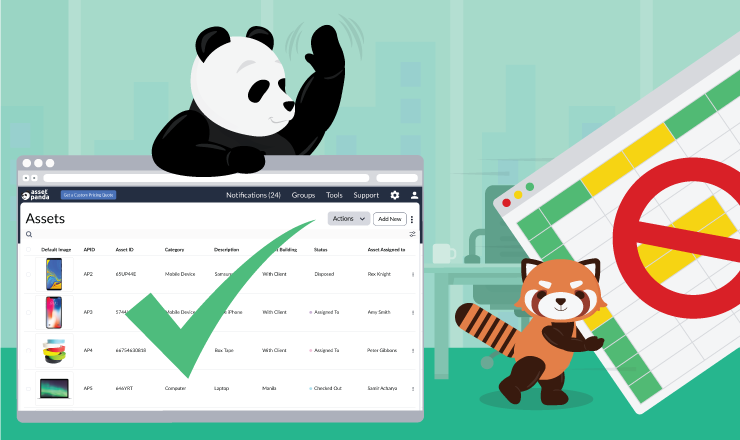Building an Effective IT Inventory Audit Process

Your IT asset management (ITAM) program is only as good as your data. In order to keep your data up-to-date and accurate, it is essential to conduct routine audits of your IT asset inventory. While we know audits can seem daunting at first glance, a comprehensive and repeatable audit process will save your organization lots of time and headaches in the long run.
Here are the steps you can take to build an effective IT inventory audit process.
Outline your IT asset audit process
As with any process, the first step in your audit procedure is to plan and document exactly what you want it to look like. Define the objectives of the IT inventory audit along with each step of the process. It's important to note you may have multiple iterations of this documented process as there may be slightly different steps to take when auditing IT hardware versus software. Of course, be sure to include any relevant resources (e.g., links, help center guides), stakeholder information, and timelines in your documented audit process.
Choose the right IT audit software
Once you've taken stock of your entire IT asset inventory, you need to ensure you have the right software in place to audit it effectively. If you're using an IT asset management software, see what audit capabilities it offers – you may already have an audit solution at your fingertips! Whether you're vetting your current asset management solution or other audit tools, here are a few features to consider to make your IT inventory audits as efficient as possible:
- A mobile app: IT audit software that offers a mobile app can save your team lots of time and energy. Rather than carrying a laptop or bulky scanner through an office, warehouse, or job site, your employees can get what they need more quickly (and safely!). Plus, a mobile app will save you even more time if it offers...
- Built-in barcode technology: A mobile app with built-in barcode technology will not only save your team even more time but will also reduce the risk of errors by eliminating manual entry. This technology will also allow you to easily create barcodes or QR codes for new items in the future and avoid the additional cost of third-party barcode generators.
- Unlimited users: With the ability to add unlimited users to your IT inventory audit platform, you'll be able to get your entire team on the same page. Not to mention, you can easily build and assign audits to the right team members to help you stay on schedule. This feature is especially important for hybrid and remote-first companies.
- Robust audit reporting: While you want to make the actual audit process as easy as possible, you can't draw the right insights without the right reports. Ensure that your chosen solution offers robust reporting filters and/or a full audit dashboard so you can effectively analyze your data and make better, informed decisions.
Create and assign audits
With your IT inventory accounted for and your asset audit software in place, you're ready to actually build and assign your audits. As you create these audits, consider the different groupings for each, such as location, group (e.g., hardware or software), category (e.g., laptops, monitors, servers), etc. Of course, if your organization is on the smaller side, you may only create a couple of audits to start.
Once you've built your audits and trained your team on your documented audit process, you're ready to assign them to your team members. If it's possible in your software, set your audits to your desired recurring frequency (e.g., monthly or quarterly) to maintain data accuracy.
Analyze audit reports
After your audits are completed, it's time to analyze the reports. While you may have other specific metrics to evaluate, you'll primarily want to use these reports to note any discrepancies within your IT inventory. Of course, missing items are the biggest discrepancies to consider, but also factor in any unexpectedly damaged devices, devices in different locations, or ones with different statuses (e.g., assigned to an employee when they were expected to be available). This will allow you to hold your employees accountable as needed for any lost or damaged assets and identify trends and potential room for improvement over time.
Act on any data discrepancies
If you've identified any discrepancies or non-compliance issues within your audit reports, you can then take the necessary steps to hold the right people accountable and correct policies as necessary. During this step, you may also need to update your asset records to account for these discrepancies so your data is current. However, if you're completing these audits directly through your IT asset management system, your records will update automatically once the audit is completed.
While it may take some time to build and implement your initial IT inventory audit process, your organization will save plenty of time and resources in the future with a replicable audit system in place. With more accurate data on your IT asset inventory, you'll not only improve data accuracy but also increase efficiency, accountability, and even compliance.
For even more tips to better manage and audit your IT hardware, read our Complete Guide to Effective IT Inventory Audits.
If you're ready to switch to a comprehensive IT asset management and audit tool, Asset Panda's got you covered! Request your demo today to get started.
Related News & Press

Learn more from an Asset Panda expert
Get a FREE consultation with an asset tracking expert to find out how you can transform your asset tracking.
Contact our Sales Team at (888) 928-6112


